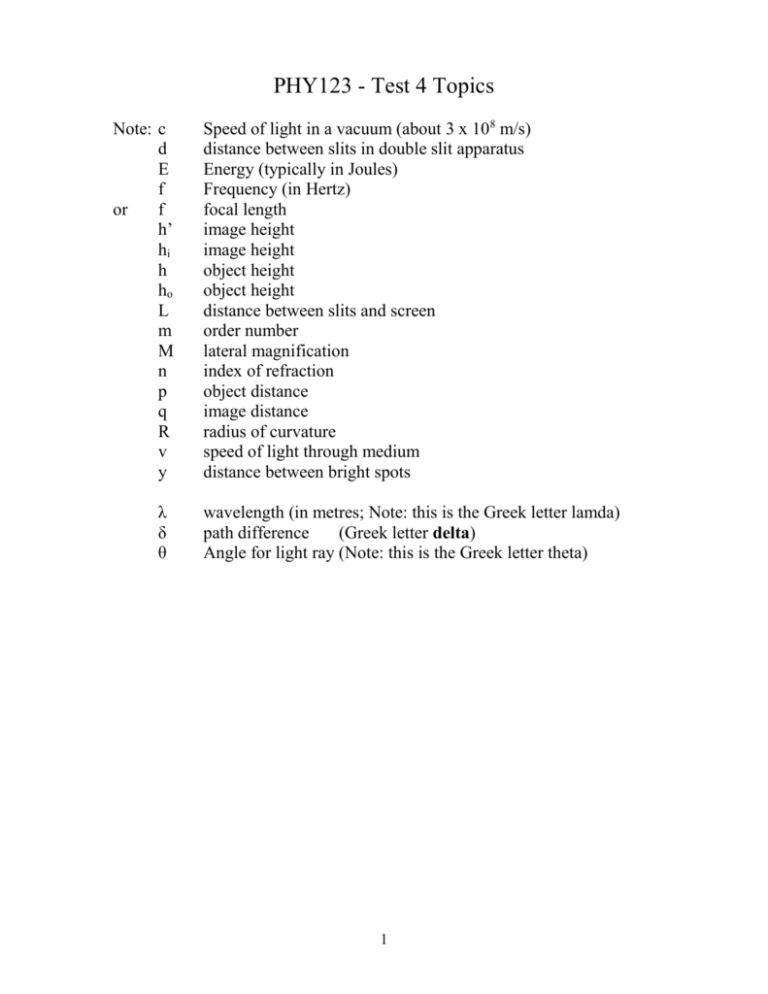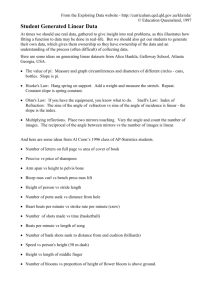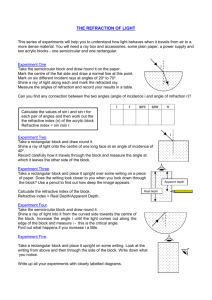PHY123 Test 4 Topics
advertisement

PHY123 - Test 4 Topics Note: c d E f or f h’ hi h ho L m M n p q R v y λ δ θ Speed of light in a vacuum (about 3 x 108 m/s) distance between slits in double slit apparatus Energy (typically in Joules) Frequency (in Hertz) focal length image height image height object height object height distance between slits and screen order number lateral magnification index of refraction object distance image distance radius of curvature speed of light through medium distance between bright spots wavelength (in metres; Note: this is the Greek letter lamda) path difference (Greek letter delta) Angle for light ray (Note: this is the Greek letter theta) 1 Equation T4.1 The energy contained in a photon of light E hf depends only upon the frequency of the light itself. To find the amount of energy in the light (in Joules), multiply the frequency of the light (in Hertz) by Planck’s constant. (Planck’s constant – h is 6.63 x 10-34 J·s) 1 ' 1 Equation T4.2 This is part of the Law of Reflection. The Law of Reflection states that anytime that a wave gets reflected the angle of incidence will equal the angle of reflectance (which is what this equation is saying) and the incident light ray, the reflected light ray and the normal all lay in the same plane. Note: the angles for the light rays are always measured with respect to a normal line drawn at the point where the light ray strikes the surface of whatever it interacts with. This is true for refraction as well as reflection. sin θ 2 v 2 constant This equation simply says that sin θ1 v1 the ratio of the sine of the angle of refractance to the sine on the angle of incidence will be equal to the ratio of the speed of light in the new material to the speed of light in the original material. Equation T4.3 Note: the direction that the light travels in changes because of the change in the speed of light. The speed of light is only supposed to be a constant in a vacuum. When light travels through anything else, it slows down. speed of light in a vacuum c This equation is speed of light in a medium v how the index of refraction (n) is defined. It essentially is a number (no units – it is a dimensionless quantity) that indicates the amount that the light slows down by when traveling through this material. For example most types of glass have an index of refraction around 1.5. This means that light travels 1.5 times faster in a vacuum that it does through glass. Equation T4.4 n 2 c 1 v1 n1 n 2 Equation T4.5 Because there is a specific 2 v2 c n1 n2 relationship between the wavelength, frequency and the speed of light, and the frequency of the light will remain constant, there will be a specific relationship between the wavelength of light, the speed of light and the index of refraction. This equation does not really give anything new; it is simply using algebra to play with equations already given. λ o wavelength of light in a vacuum This λn wavelength of light in medium gives you another way to calculate the index of refraction, this time based upon the wavelength of the light wave instead of the speed of light. Equation T4.6 n n1 sin 1 n 2 sin 2 Equation T4.7 This is the standard form for Snell’s Law. Snell’s Law is the relationship between the angles for the incident and refracted light rays in terms to the speed of light in the two materials that the light is moving through. Note: anytime that light passes from one material into another where the index of refraction is higher (meaning that the light has slowed down) is will actually bend (a.k.a. refract) towards the normal. When a light ray passes from one material into another where the index of refraction is lower (meaning that the light speeds up) is will actually bend (a.k.a. refract) away from the normal. n2 When light tries to pass from one material n1 into another where the speed of light is higher (i.e. a lower index of refraction) the light will tend to bend away from the normal. This means that the angle of refractance will be higher than the angle of incidence. Therefore the angle of refractance will reach 90° before the incident angle does. The angle of incidence that causes the refracted angle to be 90° is called the “critical angle”. If the angle of incidence is increased beyond this point, then the light ray will not pass the boundary separating the two materials. Instead it will be reflected back into the same material in a process that is called “total internal reflectance”. Equation T4.8 sin c 3 The sine of the critical angle can be found by taking the ratio of the index of refraction in the new material to the index of refraction in the original material. Note: if you switch the locations of the two materials you will get an error message when you try to find the angle by trying to calculate the arcsin of this ratio. (The sine of an angle can never be larger than 1.) n θ c sin 1 2 Note: this equation will give you the critical angle in n 1 degrees only if the calculator is in the degree mode. image height h' h i The (lateral) object height h h o magnification of an image is the ratio of the height of the image to the height of the object. M Equation T4.9 h' q The ratio of the image height to object h p height will be equal to the ratio of the image distance to the object distance. Therefore the magnification can be found by calculating the ratio of the image distance to the object distance. Equation T4.10 Notes: - - M Distances measured to a point behind the mirror are listed as negative distances and distances measured to points in front of the mirror are listed as positive. A “real” image is one that forms at a point where the light rays actually pass through that location. A “virtual” image is one that appears to form at a point that the light rays never pass through. Images formed in plane (flat) mirrors are always virtual and upright. 4 Equation T4.11 1 1 2 p q R Mirror equation (usually shown as equation T4.13) R 2 Equation T4.12 f Equation T4.13 1 1 1 p q f 5 δ r2 r1 d sinθ Equation T4.14 The distance between the slits and the bright spots on the screen (except for the central bright fringe where m = 0) differs by some integer multiple of the wavelength. The difference in the lengths of these two light rays (listed as r1 and r2) is shown as the Greek letter delta (δ). Equation T4.15 m = 0, ±1, ±2 … m is the δ d sinθ bright m order number This equation can be used to calculate the “path differences” for the location of the bright (spots) fringes that show up on the screen. 1 δ d sinθ dark m m = 0, ±1, ±2 … 2 This equation can be used to calculate the “path differences” for the location of the dark (spots) fringes that show up on the screen. Equation T4.16 y L tan L sin Equation T4.17 The separation distance between the central order bright fringe (m = 0) and the first order bright fringe (m = 1) can be found by treating the angle of separation as part of a right angle triangle. The tangent of an angle is approximately equal to the sine of that same angle as long as the angle is small and the angle is written in radians. 6 Equation T4.18 y bright L m d m = 0, ±1, ±2 … m is the order number The separation distance from the central order bright fringe to any of the other bright fringes can be calculated using the formula shown above. Equation T4.19 y dark L 1 m m = 0, ±1, ±2 … d 2 m is the order number The separation distance from the central order bright fringe to any of the other bright fringes can be calculated using the formula shown above. Note: the dark spots (fringes) will be between the bright spots. Equation T4.20 This equation can d sin θ bright m λ m = 0, 1, 2 … be used to determine the locations of the bright (spots) fringes for a diffraction grating. Note: this equation is essentially the same as for Young’s Double Slit experiment. The symbol d is still the distance between adjacent/lines in the diffraction grating. 7 Any time that light passes from one material into another and you get refraction at the boundary separating the two materials, some of the light will reflect off this boundary. This reflection off the surface separating the two materials is called a Fresnel Reflection. The amount of light that reflects off the surface (in terms of a percentage of the incident light) can be calculated as shown below. 2 n1 n 0 x 100% Equation T4.21 n1 n 0 In this equation n0 and n1 are the values for the index of refraction for the two materials involved. Note: the light that reflects off the boundary separating the two materials will obey the Law of Reflection. sin θ n1 n 2 Equation T4.22 Just because an incoming light ray strikes the core at the end of an optical fiber it does not mean that it will travel through the optical fiber and come out the other end. If the angle of incidence (as measured with respect to the normal, which is shown in the picture above as a dotted line) is too great then when the light ray strikes the core/cladding interface it will exceed the critical angle and refract out into the cladding and get “lost”. The range of incoming light rays that will be allowed to pass through the optical fiber is described in terms of being within the “acceptance cone”. The angle shown as θ (theta) is the half-angle of this acceptance cone and the value for this angle depends upon the index of refraction for the core and the cladding. 2 2 2 8









